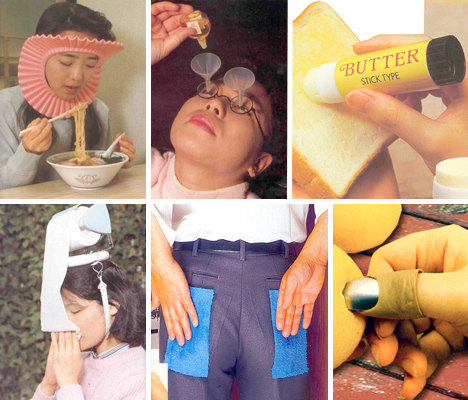The Shatter-Park, it turned out, was no idle barstool concoction. It was a Chindogu, in the same class as breakthroughs like the Hay Fever Hat (which dispenses toilet paper for nose-blowing), the Soap Recycler (a vice that mashes leftover bits together), and the Portable Stoplight (a handheld traffic signal for pedestrians). These and hundreds more are the brainchildren of Japan’s Kenji Kawakami, creator of the decade-old art of “unuseless invention.” Literally, Chindogu means “strange tool” (the “unuseless” tag refers to objects that, while not exactly without purpose, barely justify their own existence). In short, they are objects whose designs go to extraordinary—and often ridiculously cumbersome lengths to solve everyday problems.
In the early 1990s, Kawakami, now 55, dreamed up all kinds of unuseless objects while editing a Japanese magazine that reviewed mail order catalogs. A former scriptwriter for television and designer of the Japanese Bicycle Museum, Kawakami published a few of his inventions and discovered that they were wildly popular among his readers. Around the same time, he crossed paths with Dan Papia, who edited the English-language magazine Tokyo Journal, and whose claim to fame was christening the Tokyo Dome the Big Egg.

Papia helped Kawakami assemble his oddball ideas into a book. Though it was to be published in English, Papia thought a Japanese name would give it credibility. “I wanted it to sound like an ancient art,” he says. The book, 101 Unuseless Japanese Inventions: The Art of Chindogu, appeared in 1993. Spurred by healthy sales, Papia and Kawakami issued 99 More Unuseless Japanese Inventions two years later. The books spawned the formation of Chindogu clubs around the world and led to the founding of the International Chindogu Society—the paperback of the first edition claims the organization “10,000 strong”— and turned Kawakami into a minor celebrity in Japan.

After the second book’s publication, though, Papia and Kawakami were split over the movement’s philosophical direction. In the U.S., talks with David Letterman’s Late Show fell through, and plans for 101 Unuseless American Inventions, never got off the ground.
Though Papia had already begun moving on to other things, he was chagrined by the winnowing of interest. He had big plans for Chindogu, envisioning it as a participatory design revolution for the masses. “My goal was to get the word into the dictionary, like karate and karaoke and other Japanese words,” he says. “I wanted to see it catch on as an art form,” whereas Kawakami, Papia complains, “wanted it to just sort of be his.” Not long after the second book came out, Papia returned to the States, where he enrolled in film school and started a new life as a screenwriter. Meanwhile, Kawakami rode out his notoriety in Japan. Chindogu seemed confined to the Table Trash Can of history.

